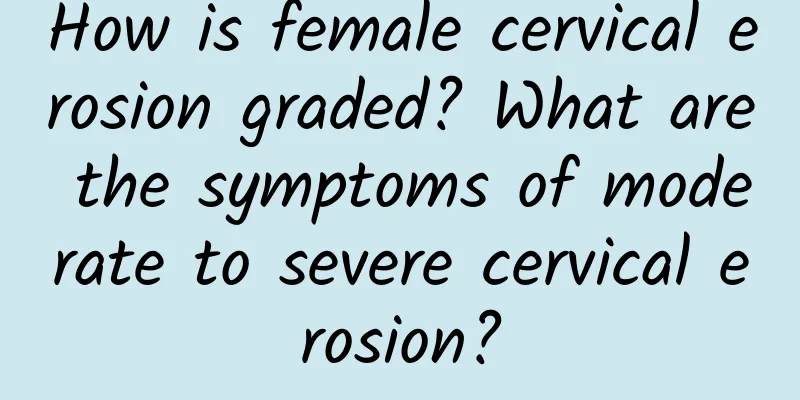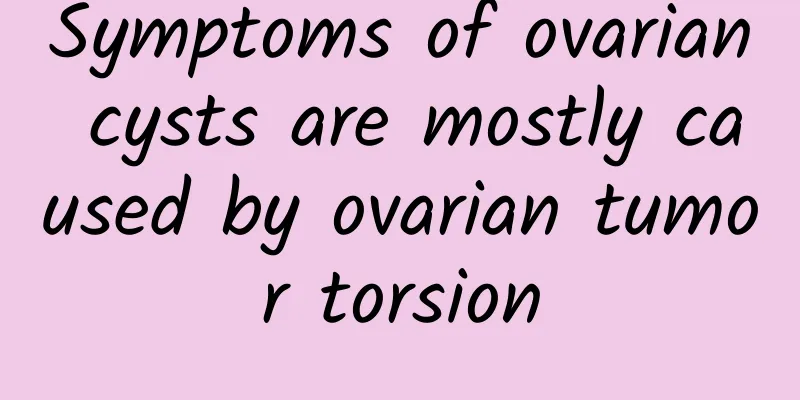How is female cervical erosion graded? What are the symptoms of moderate to severe cervical erosion?

|
The third degree of cervical erosion is the most serious degree of cervical erosion. The erosion area has exceeded 2/3 of the cervical surface. The third degree of cervical erosion greatly increases the risk of infertility and cancer. Due to the stimulation of inflammatory secretions, the squamous epithelial cells of the mucosa of the external opening of the cervical canal fall off and are covered by proliferating columnar epithelium. The surface color is bright red and smooth or uneven. This change is called "cervical erosion". Cervical erosion grades 1. Mild erosion: The erosion area accounts for less than 1/3 of the entire cervical area; 2. Moderate erosion: The erosion area accounts for 1/3 to 2/3 of the entire cervical area; 3. Severe erosion (cervical erosion degree 3): The erosion area accounts for more than 2/3 of the entire cervical area. What are the symptoms of moderate and severe cervical erosion? 1. Symptoms of leucorrhea: When cervical erosion develops into severe, the symptoms of increased leucorrhea will be very obvious. If the inflammation is not obvious, the leucorrhea symptoms will mainly be transparent mucus. If severe cervical erosion is accompanied by obvious inflammation, the leucorrhea will be yellow purulent and sticky. 2. Pain symptoms: Generally speaking, the pain symptoms of patients with severe cervical erosion are not obvious, but when the pathogens involve the surrounding deeper, it can cause chronic paracervical connective tissue inflammation, showing lumbar and sacral pain, pelvic pain and dysmenorrhea. If the inflammation spreads to the main ligament, it can cause sexual intercourse pain and affect sexual life. 3. Bladder irritation symptoms: The inflammatory factors of cervical erosion can spread or directly extend to the bladder triangle, thereby irritating the bladder and causing the patient to experience symptoms such as frequent urination, urgency, and pain when urinating, and sometimes secondary urinary tract infection. 4. Abdominal distension: One of the common symptoms of severe cervical erosion is dysmenorrhea, with symptoms such as a feeling of distension in the lower abdomen, frequent urination, and urgency to urinate. 5. Irregular vaginal bleeding: Patients with severe cervical erosion may have symptoms of irregular vaginal bleeding or contact bleeding. |
Recommend
Symptoms of cervical precancerous lesions
Worldwide, the incidence of cervical cancer ranks...
Are uterine fibroids hereditary?
Will uterine fibroids be inherited? This is a que...
Why do you have headaches during menstruation? Exercise moderately
Headaches in women during menstruation are genera...
Will long-term vaginitis turn into cancer?
Vaginitis is a common gynecological disease, main...
Introduction: Several methods to help relieve menstrual cramps
Eating something during dysmenorrhea can help rel...
What are the characteristics of chronic cervicitis bleeding
The bleeding characteristics of chronic cerviciti...
Do cervical polyps require surgery? Generally, surgical treatment
In recent years, the incidence of cervical polyps...
The number of men with gynecomastia is increasing. Low testosterone leads to enlarged breasts.
Modern people's diet is too westernized, and ...
Some common symptoms of pelvic inflammatory disease patients
There are many kinds of gynecological diseases, a...
What ointment is used for gynecological vulvar itching and white spots? What medicine is there to relieve itching for gynecological white spots?
Gynecological vulvar pruritus leukoplakia is a co...
What causes ectopic pregnancy?
What are the causes of ectopic pregnancy? Ectopic...
Sitting for a long time can cause cervical erosion in women
Cervical erosion is not a disease, but a manifest...
Key points for diagnosis of functional uterine bleeding
Dysfunctional uterine bleeding generally does not...
Changhua Animal Control Station blacklists those who illegally use clenbuterol
It is rumored that domestic pig farmers are also ...
Experts analyze what is going on with female vulvar leukoplakia?
Female vulvar leukoplakia is a disease that many ...









